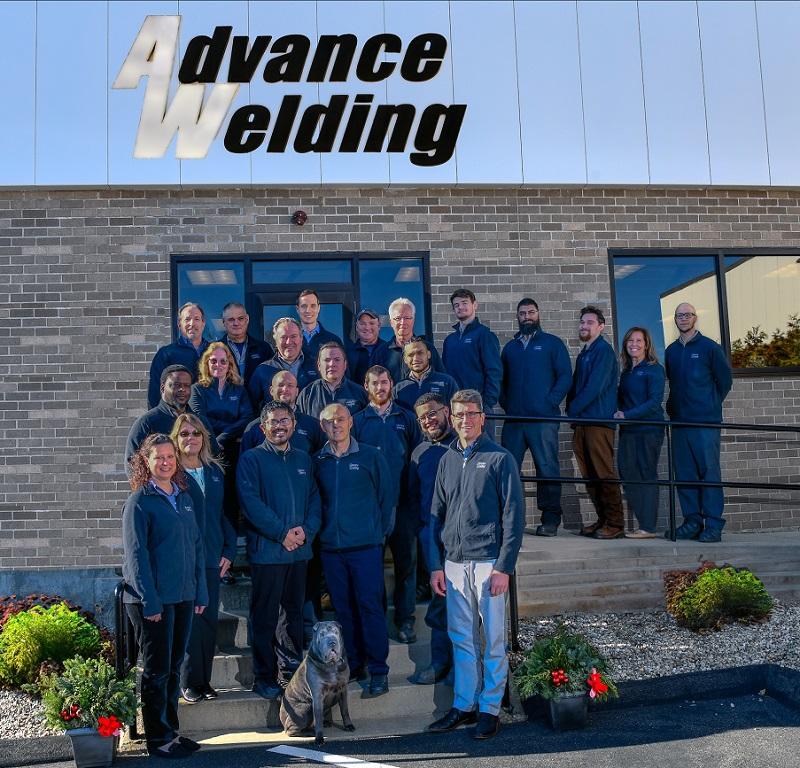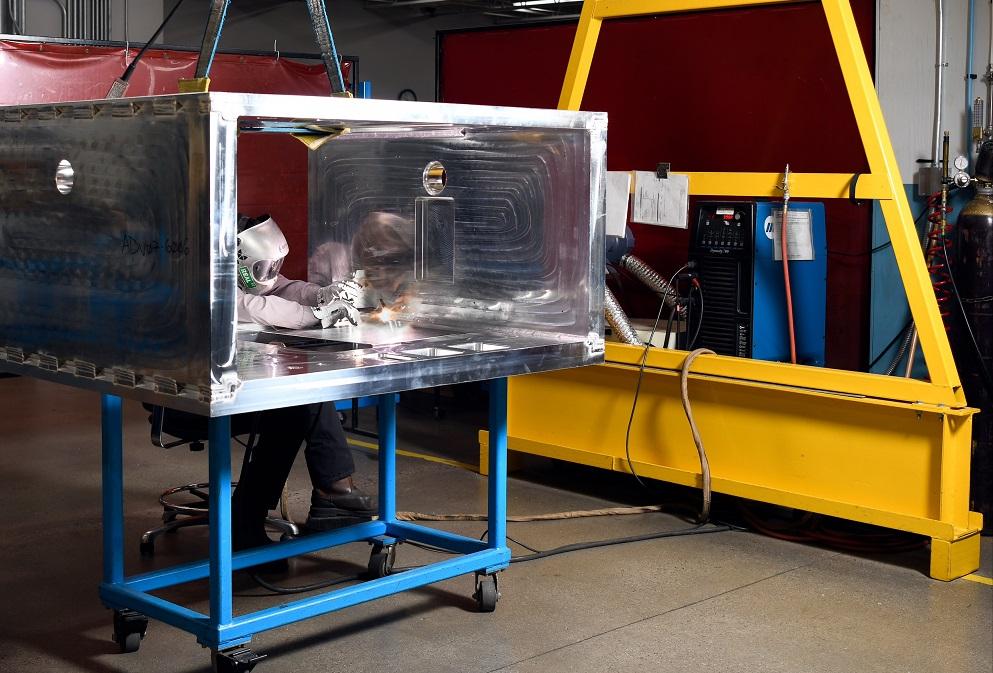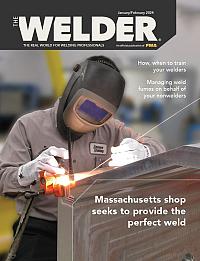Editor
- FMA
- The Fabricator
- FABTECH
- Canadian Metalworking
Categories
- Additive Manufacturing
- Aluminum Welding
- Arc Welding
- Assembly and Joining
- Automation and Robotics
- Bending and Forming
- Consumables
- Cutting and Weld Prep
- Electric Vehicles
- En Español
- Finishing
- Hydroforming
- Laser Cutting
- Laser Welding
- Machining
- Manufacturing Software
- Materials Handling
- Metals/Materials
- Oxyfuel Cutting
- Plasma Cutting
- Power Tools
- Punching and Other Holemaking
- Roll Forming
- Safety
- Sawing
- Shearing
- Shop Management
- Testing and Measuring
- Tube and Pipe Fabrication
- Tube and Pipe Production
- Waterjet Cutting
Industry Directory
Webcasts
Podcasts
FAB 40
Advertise
Subscribe
Account Login
Search
Massachusetts welding shop tells how to succeed in aerospace
Growth, evolution part of Advance Welding’s 45-year success in specialty metal fabrication
- By Rafael Guerrero
- January 17, 2024
- Article
- Arc Welding

Massachusetts-based Advance Welding’s approach to specialty welding and metal fabrication has helped it develop a good reputation among customers in multiple sectors, including aerospace, defense, automotive, energy, medical, and semiconductor. Advance Welding
In 2023, Advance Welding celebrated 45 years in business. Throughout its existence, the New England business has been a family affair.
Kaz Kielb and his wife, Carol, launched Advance Welding more than four decades ago in West Springfield, Mass. Their children, Chris Kielb and Melinda Martin, have since taken over; the shop is now located east of the Connecticut River in nearby Springfield.
“There aren't many shops that can do what we do under one roof,” said Chris Kielb, the president and owner of Advance Welding.
“It doesn’t seem like it’s been 45 years,” added Martin, who is the company’s treasurer.
The knowledge and expertise Advance Welding attained over multiple decades has allowed it to compete and serve the aerospace, defense, automotive, energy, medical, and semiconductor sectors. But the high and changing expectations of these sectors have meant the Advance team has had to adjust and adapt over time by pursuing and maintaining vital aerospace industry certifications, purchasing a fellow New England shop, and expanding into electron beam welding.
About Nadcap
As Kielb put it, “My philosophy was always to have Advance Welding be a viable source for any prime [contractors], and they didn't have a reason not to come to us.”
To keep pace with this philosophy, the company had to secure all the necessary certifications, which include Nadcap, the Federal Aviation Administration (FAA), AS9100D, ISO 9001:2015, and multiple AWS codes. The shop is an FAA-certified repair station; Kielb said it was his dad’s dream for the shop to attain the FAA certification, which it did about 15 years ago.
Advance, meanwhile, became Nadcap accredited in 2006. Nadcap is the globally recognized accreditation program that covers many of the processes in aerospace manufacturing.
Much of the aerospace industry follows the Nadcap program, whether it be a large aerospace manufacturer or a smaller supplier seeking to sell products or services to larger manufacturers. A Nadcap-accredited supplier like Advance Welding must undergo a reaccreditation process periodically to verify the quality of the work is maintained and meets requirements. This is in addition to prime aerospace manufacturing customers stopping by Advance Welding for occasional checkups.
The Nadcap community also meets several times a year to discuss things like development of and changes to the auditing criteria.

In 1978, Kaz Kielb (pictured) and his wife, Carol, founded Advance Welding. Their children have since taken over. Advance Welding
“Melinda and I have been very active in the Nadcap community,” Kielb said. “A couple of years after we became Nadcap accredited, we started going to the North American meeting, which is held every October in Pittsburgh. Both of us used to go to these meetings together, and I eventually became a supplier voting member.
“We're a small company right now—we have 24 people,” he continued. “But there, we sit in these rooms with these big, big primes and they listen to us.”
Perfecting a Weld
On the Advance Welding website, three words sit underneath its name: The perfect weld.
Given the projects the company’s customers can request and what sectors they work in, it is a phrase Advance Welding strives to live up to. That quest for the perfect weld is multifaceted and includes hiring and retaining talented and engaged people, growing through a strategic acquisition, and partnering with local educational institutions.
People. Many of the company’s two dozen employees have years of experience under their belts. Kielb said two of his TIG welder technicians have almost four decades of experience—all with Advance.
“I knew these guys when I was in my early teens; they're like big brothers to me. You know, you're around people for 40 years and they become kind of like family,” he said.
“You have to have the people that have the skills,” Kielb added. “And you have to have the equipment that's capable of doing the work. And that's just the basic requirements of a nonaerospace facility.”
Strategic Acquisition. But it’s not just about the manual welding. For instance, Advance’s acquisition of Connecticut-based KTI Inc. brought with it new personnel and machinery. This included KTI’s electron beam welding and laser beam welding capabilities.
Kielb said moving the equipment posed a logistical challenge for the team. For instance, one of the electron beam chambers weighed 49,000 lbs.
“We literally had to remove brick and mortar, open the garage doors to get this monster piece of equipment out, get it on the back of a flatbed, and then move it 20 miles up the road to Springfield, and then open up my garage doors here, and get this behemoth moved into the shop,” he said.

Advance Welding employs about two dozen people. The business was based in West Springfield, Mass., before making the move to Springfield. Lisa Thomas-DuFresne Photo
Electron beam welding works somewhat like the cathode ray tube (CRT) televisions of old. A beam of electrons is projected through a vacuum chamber onto the workpiece. When the electrons hit the workpiece, their kinetic energy is transformed into thermal energy, becoming the heat source for the welding process.
“The advantage is that a minimal amount of heat is put into the part for a given depth of penetration,” said John Marshall, a process and sales engineer at Advance. “The fact that the process occurs under vacuum is kind of a side benefit. It has to happen in a vacuum because electrons won't travel through space if there's air molecules floating around.”
Because everything happens in a vacuum, you don’t have to worry about oxygen or nitrogen contaminating the weld puddle like you would while TIG welding, Marshall said.
Another advantage? Workpiece manipulation is less dependent on the welder in electron beam welding.
“With TIG welding, we're adding wire manually and we're holding the torch manually. Generally speaking, it's a manual process, and we're adding filler wire and holding the torch and manipulating the workpiece and the torch and the wire,” he said. “Whereas with electron beam welding, what we're relying on more is the tooling and the fixtures to automatically move the part under the beam.”
Other unique advantages of electron beam welding include its repeatability, minimal distortion, the capability to weld together dissimilar metals, and its ability to handle metals with high melting points and high heat capacities.
“We document the entire process so that any one of our qualified operators can take that procedure and implement it and yield the same result,” Marshall said.
Electron beam welding does have its drawbacks. The parts sizes it accommodates can be limited depending on the welding chamber, its welding cycle time depends on the vacuum pump-down time, and the fixturing and development process can be extensive.
“It's not like you can go out to the local weld shop and buy an [electron beam] welder,” Kielb added.
Partnering With Education. Advance Welding has gotten involved with a local school to evaluate the technology and skills-building options available to the next generation of workers. Kielb said a local university has plans to create a state-of-the-art welding program and facility, and he has met with school administrators to discuss what should be part of their curriculum.

In electron beam welding, a beam of electrons is projected through a vacuum chamber onto the workpiece. When the electrons hit the workpiece, kinetic energy is transformed into thermal energy, becoming the heat source for the welding process. Lisa Thomas-DuFresne Photo
The work with the school also has generated ideas on how the company can further embrace welding technology, such as cobots.
“We were working with one of their cobots, and that's one of the things that I'm looking to see how I can implement here in Advance Welding,” he said.
Growing Up
The company’s move to a larger location in Springfield helped fuel its growth over the last decade. Kielb said the shop has grown in size, revenue, and personnel. The purchase of KTI, meanwhile, increased sales by 25%, though the purchase did put Advance Welding “in the hole” at first, he added.
The shop’s capabilities allow Advance Welding to tackle multiple fusion welding processes, brazing, heat treating, and some fabricating, including bending, rolling, forming, and limited machining.
“We can make a dozen parts or a hundred parts very competitively and very accurately with this older sheet metal equipment that we have,” Kielb said.
“I mean, we've changed a lot. We've grown a lot. [I’m] glad Mom and Dad are still here to see where we are,” added Martin. “I know they're really proud of us.”
Martin is more reserved and cautious in her approach to the business, she said. Her brother is more of a risk taker. Their personality differences provide a “checks and balance” of sorts, they said.
The two learned plenty from their parents when they were younger, whether by sitting through audits or sweeping the floors. But they also learned how to move the business forward and how to grow.
Like other family-run businesses, it hasn’t always been smooth sailing. For instance, the move from West Springfield to Springfield was a contentious decision.
“The family kind of frowned upon it because our roots were in West Springfield. Our parents and even my sister were like, ‘If we move from West Springfield, our customers aren't going to come with us,’” Kielb said.

The shop’s capabilities allow Advance Welding to go into multiple fusion welding processes, brazing, heat treating, and some fabricating, including bending, rolling, forming, and limited machining. Lisa Thomas-DuFresne Photo
Advance is comfortable where it is right now, but Kielb said he’d like to add more space to the Springfield facility.
“We're not a typical weld shop, you know,” he said. “When we moved here 10 years ago, I wanted a state-of-the-art, clean facility. It's not your great-grandfather's welding shop anymore.”
About the Author

Rafael Guerrero
2135 Point Blvd.
Elgin, IL 60123
(815)-227-8242
Rafael Guerrero. was named editor of The Welder in April 2022. He spent nine years as a journalist in newspapers in the Midwest and Pacific Northwest, covering topics and communities in central Illinois, Washington, and the Chicago area.
About the Publication
subscribe now

The Welder, formerly known as Practical Welding Today, is a showcase of the real people who make the products we use and work with every day. This magazine has served the welding community in North America well for more than 20 years.
start your free subscription- Stay connected from anywhere

Easily access valuable industry resources now with full access to the digital edition of The Fabricator.

Easily access valuable industry resources now with full access to the digital edition of The Welder.

Easily access valuable industry resources now with full access to the digital edition of The Tube and Pipe Journal.
- Podcasting
- Podcast:
- The Fabricator Podcast
- Published:
- 04/16/2024
- Running Time:
- 63:29
In this episode of The Fabricator Podcast, Caleb Chamberlain, co-founder and CEO of OSH Cut, discusses his company’s...
- Trending Articles
Sheffield Forgemasters makes global leap in welding technology

ESAB unveils Texas facility renovation

Engine-driven welding machines include integrated air compressors

How welders can stay safe during grinding

The impact of sine and square waves in aluminum AC welding, Part I

- Industry Events
16th Annual Safety Conference
- April 30 - May 1, 2024
- Elgin,
Pipe and Tube Conference
- May 21 - 22, 2024
- Omaha, NE
World-Class Roll Forming Workshop
- June 5 - 6, 2024
- Louisville, KY
Advanced Laser Application Workshop
- June 25 - 27, 2024
- Novi, MI


























